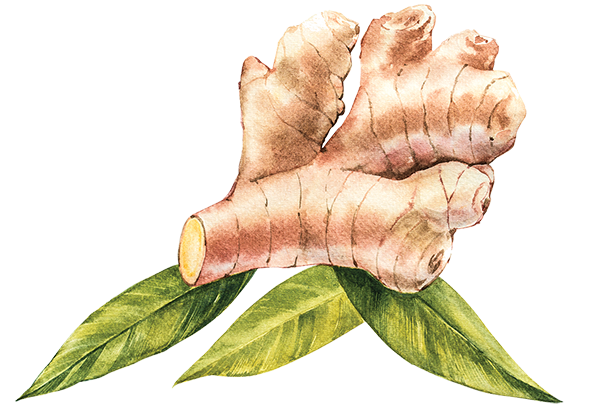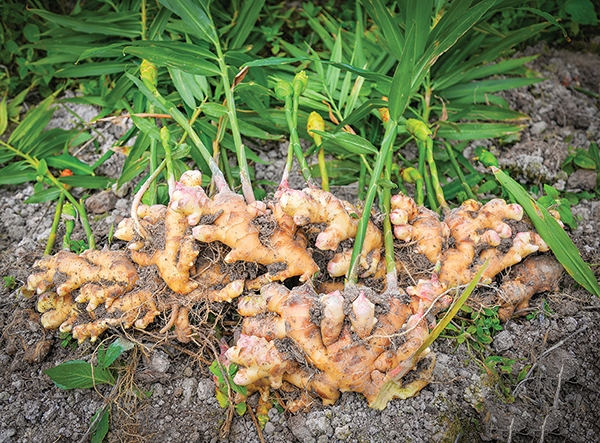 The Superfood of All Superfoods
The Superfood of All Superfoods
Ginger (Zingiber officinale) is a popular herb used globally, both in the culinary world and in herbal medicine. The ginger plant is thought to have originated in southeastern Asia, and its spiritual and medicinal uses date back about 5,000 years in Southeast Asia, China, and India.1 In the first century CE, ginger made its way into the Mediterranean region, brought by traders, and by the 11th century, ginger was being traded in England, the West Indies, Chile, and Spain.2 Ginger was highly valued as a flavoring agent and for its medicinal and spiritual uses, and some sources state that in the 14th century CE, a pound of ginger was equivalent in price to that of one sheep.1 By 1550 CE, Europe was importing 2,000 tons of ginger a year from the East Indies.1
 The ginger plant, which can grow up to three feet in height, has green reedy stems wrapped in sheaths, from which long narrow leaves emerge. It somewhat resembles bamboo. Ginger flowers emerge from dense cone-like spikes. Ginger thrives best in warm, humid environments.2
The ginger plant, which can grow up to three feet in height, has green reedy stems wrapped in sheaths, from which long narrow leaves emerge. It somewhat resembles bamboo. Ginger flowers emerge from dense cone-like spikes. Ginger thrives best in warm, humid environments.2
The spicy aromatic herb/spice we know and love as ginger is often referred to as ginger root, but this is a misnomer because it is the rhizomes of the plant, not the roots, that are harvested. Interesting to note: ginger is propagated by planting root stalk cuttings, and this method of cultivation has been used for so long that ginger no longer produces seeds.2 When harvested, the rhizomes are lifted from the ground, cleaned, and dried, resulting in the brownish tan, knobby, fist-sized lumps we see at the grocery store.2
NUTRITIONAL INFORMATION
One tablespoon of fresh ginger has 4.8 calories, 1.07 grams of carbohydrates, 0.12g of dietary fiber, 0.11g of protein, 0.5g of fat, and 0.1g of sugar.3 Ginger contains trace amounts of vitamins B3 and B6, iron, potassium, vitamin C, magnesium, phosphorus, zinc, folate, riboflavin, and niacin.3
HEALTH BENEFITS
Ginger is the epitome of a superfood. Over 400 bioactive components have been found in ginger, including phenolic (gingerols, shogaols, paradols, quercetin, zingerone, gingerenone-A, and 6-dehydrogingerdione) and terpene (β-bisabolene, α-curcumene, zingiberene, α-farnesene, and β-sesquiphellandrene) compounds. Additionally, ginger contains polysaccharides, lipids, organic acids, and raw fiber.4–19 Numerous studies have demonstrated multiple biological activities in ginger, including antioxidant, anti-inflammatory, antimicrobial, anticancer, neuroprotective, cardiovascular protective, respiratory protective, antiobesity, antidiabetic, antinausea, and antiemetic properties.4–19 In short, ginger has been well-studied, and its medicinal effects are well supported by numerous high-quality scientific reports.
Gingerols are the primary bioactive components in ginger, and their strong antioxidant and anti-inflammatory properties are responsible for much of ginger’s other medicinal properties.4–19
PREPARATION
Fresh ginger can be chopped, sliced, diced, or grated and eaten raw or cooked; it can be pickled or preserved; and it can be dried and ground into powder form (or if that is outside the scope of your daily to-dos, you could just buy it in the spice aisle). You can also get it in supplement form, as an essential oil, and as a tincture, but consult with a physician before using ginger in these forms.
BOTTOM LINE
The medicinal properties of ginger have been demonstrated in numerous animal and human studies; however, additional larger, randomized, controlled human studies are needed to better support these results..
Editor’s note. Consult with a qualified healthcare professional to determine if ginger supplementation is right for you.
SOURCES
1. The Ginger People website. Ginger history and health. 6 Nov 2017. https://gingerpeople.com/ginger-history-and-health/#:~:text=The%20known%20history%20of%20ginger,as%20much%20as%20one%20sheep! 24 May 2022.
2. The Editor of Encyclopaedia Britannica. Ginger. Britannica website. https://www.britannica.com/plant/ginger. Accessed 24 May 2022.
3. Goldman R. A detailed guide to ginger: what’s in it, why it’s good for you, and more. 12 Jul 2019. Everyday Health website. https://www.everydayhealth.com/diet-nutrition/diet/ginger-nutrition-facts-health-benefits-alternative-uses-more/. Accessed 24 May 2022.
4. Mao QQ, Xu XY, Cao SY, et al. bioactive compounds and bioactivities of ginger (Zingiber officinale Roscoe). Foods. 2019;8(6):185.
5. Zhang S, Kou X, Zhao H, et al. Zingiber officinale var. rubrum: red ginger’s medicinal uses. Molecules. 2022;27(3):775.
6. Arcusa R, Villaño D, Marhuenda J, et al. Potential role of ginger (Zingiber officinale Roscoe) in the prevention of neurodegenerative diseases. Front Nutr. 2022;9:809621.
7. Unuofin JO, Masuku NP, Paimo OK, Lebelo SL. Ginger from farmyard to town: nutritional and pharmacological applications. Front Pharmacol. 2021;12:779352.
8. Anh NH, Kim SJ, Long NP, et al. Ginger on human health: a comprehensive systematic review of 109 randomized controlled trials. Nutrients. 2020;12(1):157.
9. Mashhadi NS, Ghiasvand R, Askari G, et al. Anti-oxidative and anti-inflammatory effects of ginger in health and physical activity: review of current evidence. Int J Prev Med. 2013;4(Suppl 1):S36–S42.
10. Wang S, Zhang C, Yang G, Yang Y. Biological properties of 6-gingerol: a brief review. Nat Prod Commun. 2014;9(7):1027–1030.
11. Nikkhah Bodagh M, Maleki I, Hekmatdoost A. Ginger in gastrointestinal disorders: a systematic review of clinical trials. Food Sci Nutr. 2018;7(1):96-108.
12. Khandouzi N, Shidfar F, Rajab A, et al. The effects of ginger on fasting blood sugar, hemoglobin a1c, apolipoprotein B, apolipoprotein a-I and malondialdehyde in Type 2 diabetic patients. Iran J Pharm Res. 2015;14(1):131-140.
13. Bartels EM, Folmer VN, Bliddal H, et al. Efficacy and safety of ginger in osteoarthritis patients: a meta-analysis of randomized placebo-controlled trials. Osteoarthritis Cartilage. 2015;23(1):13–21.
14. Maharlouei N, Tabrizi R, Lankarani KB, et al. The effects of ginger intake on weight loss and metabolic profiles among overweight and obese subjects: a systematic review and meta-analysis of randomized controlled trials. Crit Rev Food Sci Nutr. 2019;59(11):1753–1766.
15. Ozgoli G, Goli M, Moattar F. Comparison of effects of ginger, mefenamic acid, and ibuprofen on pain in women with primary dysmenorrhea. J Altern Complement Med. 2009;15(2):129–132.
16. Tabibi H, Imani H, Atabak S, et al. Effects of ginger on serum lipids and lipoproteins in peritoneal dialysis patients: a randomized controlled trial. Perit Dial Int. 2016;36(2):140–145.
17. Poltronieri J, Becceneri AB, Fuzer AM, et al. [6]-gingerol as a cancer chemopreventive agent: a review of its activity on different steps of the metastatic process. Mini Rev Med Chem. 2014;14(4):313–321.
18. Azam F, Amer AM, Abulifa AR, Elzwawi MM. Ginger components as new leads for the design and development of novel multi-targeted anti-Alzheimer’s drugs: a computational investigation. Drug Des Devel Ther. 2014;8:2045-2059.
19. Karuppiah P, Rajaram S. Antibacterial effect of Allium sativum cloves and Zingiber officinale rhizomes against multiple-drug resistant clinical pathogens. Asian Pac J Trop Biomed. 2012;2(8):597–601.





